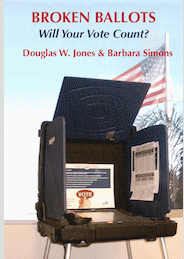Even the DC test did not subject the internet voting system to all possible threats. While potential attackers were allowed to try to hack into the election server, they obviously could not attempt to plant election-rigging malware on voters' computers. Yet, in a real internet based election, such malware is a real threat. In addition, several other threats were not tested in DC, such as a denial of service attack that would prevent voters from accessing the voting website.

Broken Ballots: Will Your Vote Count? by Douglas W Jones & Barbara Simons
(Image by Center for the Study of Language and Inf (June 15, 2012)) Details DMCA
JB: That's certainly not very reassuring. With that in mind, how can voters possibly have faith in this system of ours? And what would you recommend to improve it?
BS: For starters, states should stop allowing voters to return voted ballots over the internet unless and until we know that internet voting can be done securely. That means that it should not be possible for voter's selections to be modified by an attack on the election official's machine or by election rigging malware on the voter's machine. It also should not be possible to disenfranchise voters with a large scale denial of service attack.
In addition, we need to have "evidence-based" elections throughout the entire country. By "evidence-based" I mean that it should be possible after the election to prove that the correct candidates were elected. In order to do this, we need to eliminate ALL paperless voting machines, because it's impossible to know whether or not the results they report are accurate. Furthermore, the paperless machines still in use deploy ancient computer technology and are falling apart. They contributed significantly to the long lines in 2012, and I fear they will do so again in 2016.
The entire country should be voting on voter verified paper ballots. Since most paper ballots are counted using computerized optical scanners, verifying the accuracy of the results means verifying that the computers inside the scanners correctly recorded and counted the votes. The verification step is necessary, because the software in the computers could have bugs or even election-rigging malware. In addition, the computers may have been given incorrect instructions for reading the ballots. These instructions tell the computer that a vote in a particular location on the ballot is for candidate A, whereas a vote in a different location is for candidate B. But we know of cases where these instructions were reversed, namely that votes for candidate B were going to candidate A, and visa versa. By manually comparing the paper ballots with the machine interpretation of those ballots, and by checking that the vote tabulation was done correctly, we can determine either that the machine-declared winners truly won or that different candidates won.
JB: In that case, you'd like what's going on in Columbia County, New York, where they do exactly that: hand count each ballot and compare the results with the computer-generated tally. It's been in place since 2010 and is supported by both Democratic and Republican election commissioners. Do you think that such a system can catch on more widely?
BS: I think hand counting ballots works well in some situations. A few years ago I observed a provincial election in British Columbia, Canada, that was entirely hand counted. I was very impressed by the manner in which the Canadians ran the election and manually counted the votes. However, it was a very easy election to count, since typically the only item Canadians vote for in a provincial or federal election is the member of their province's legislative assembly or the federal parliament. (Municipal elections in Canada usually have more complicated ballots, which is one reason why a large number of small towns in Ontario allow their citizens to vote online, a dreadful idea in my opinion).
We do things differently in the U.S., especially in my home state of California - famed for our far too long ballots. Whether or not it would be a good idea to return to hand counting of all our ballots, it just ain't gonna happen. The use of computers in voting is here to stay. That means that we must focus on how to use those computers appropriately and how to apply the necessary checks on the computers.
As I mentioned earlier, we must use voter verified paper ballots in all of our governmental elections, and we must not trust the computers that record and tabulate our votes. That means that we need common sense laws, such as requiring that the number of ballots tabulated by a machine be compared with the corresponding number of voters. If there is a mismatch, the paper ballots must dominate the machine-declared results. We also need laws that mandate manual random "risk-limiting" post-election ballot audits that either determine that the machine-declared winner are the actual winners or end up conducting a total manual count of all the ballots. In the later case, the manual count should determine the winners.
There are some new paper ballot voting systems being developed that will have open (or at least disclosed) source systems. That means that, unlike the voting systems commercially available today that use proprietary software, the software in these new systems will not be secret. These systems should be less expensive and have better security, usability, accessibility, and audit features than currently available systems. Unfortunately, none will be ready in time for the 2016 election.
JB: Anything you'd like to add before we wrap this up?
BS: Dear reader, if you haven't already done so, you might consider serving as a poll worker in the upcoming election. It is an interesting, if tiring, experience. You can learn about the types of machines you will be voting on here. You also can determine if internet voting is allowed in your state here.
If you live in a state that uses insecure voting technology, either touch screen voting machines (Direct Recording Electronic or DRE) or internet voting, I hope you will contact your local election official to urge the replacement of that insecure voting technology. If you live in a state that uses paper ballots that are counted by scanners (the scanners of course use computers to tabulate the votes) but does not mandate manual post-election ballot audits, I hope you will contact your local election official to urge the adoption of strong post-election ballot audits.
JB: Thanks so much for talking with me, Barbara. It's been a pleasure.
(Note: You can view every article as one long page if you sign up as an Advocate Member, or higher).





